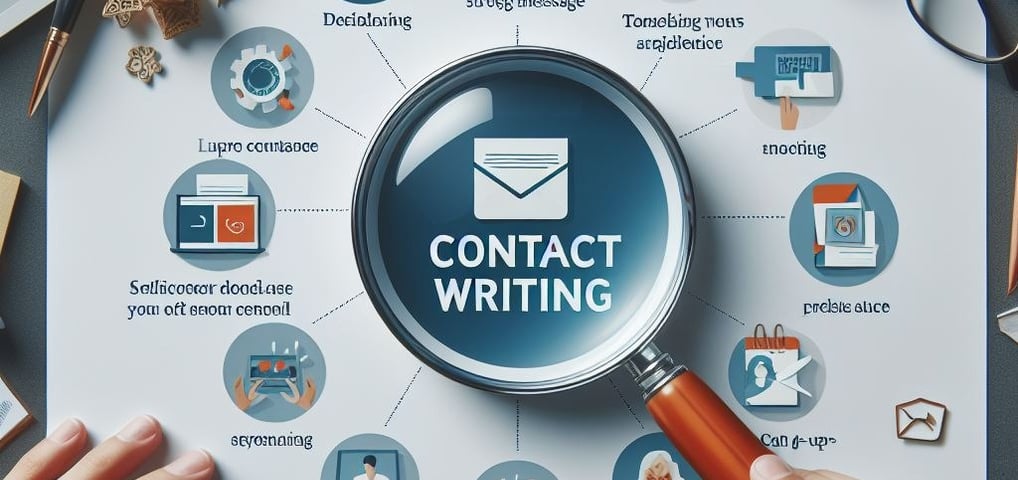
Unlock the Secrets of Powerful Contact Writing: Key Elements for Success
This article is a comprehensive, detailed guide to Contact Writing.
IT SERVICES
4/14/20243 min read



Introduction
Contact writing is an essential skill in today's digital age. Whether you're reaching out to potential clients, networking with industry professionals, or simply trying to make a connection, effective contact writing can make all the difference. In this article, we will explore the key points of contact writing and provide you with the necessary insights to craft compelling messages that resonate with your audience.
Defining Contact Writing
Contact writing refers to the act of composing emails, letters, or other forms of communication to establish or maintain a connection. It involves carefully choosing the right words, tone, and structure to convey your message effectively. Contact writing can be used in various contexts, such as business development, job applications, or even personal networking.
Types of Contact Writing
Contact writing can take on different forms depending on the purpose and audience. Some common types of contact writing include:
Cold outreach: This involves reaching out to individuals or organizations with whom you have no prior relationship. It requires a persuasive approach to capture the recipient's attention and interest.
Follow-up: Following up on previous conversations or interactions is crucial for maintaining relationships. A well-crafted follow-up message can help you stay top of mind and reinforce your previous communication.
Networking: Networking messages are aimed at building connections within your industry or professional network. These messages should be tailored to the recipient's interests and demonstrate your value.
Business proposals: When presenting a business proposal, contact writing is essential to convey your ideas, showcase your expertise, and persuade the recipient to take action.
Understanding Your Audience
Before writing any message, it's essential to understand your audience. Research the recipient's background, interests, and preferences to tailor your message accordingly. This will help you establish a connection and ensure that your message resonates with them.
Targeting Your Audience
Once you have a clear understanding of your audience, it's important to target your message specifically to them. Use language and examples that are relevant to their industry or interests. This will demonstrate that you have taken the time to personalize your communication and increase the chances of a positive response.
Clarity and Conciseness
When writing a contact message, it's crucial to be clear and concise. Avoid using jargon or complex language that may confuse the recipient. Get straight to the point and communicate the purpose of your message. Keep your sentences and paragraphs short to make your message easier to read and understand.
Personalization and Authenticity
One of the most effective ways to make your contact writing stand out is by adding a personal touch. Address the recipient by their name, reference any previous interactions or common connections, and show genuine interest in their work. This will help you establish a sense of authenticity and build trust with the recipient.
Call to Action (CTA)
Every contact message should include a clear call to action. Whether it's scheduling a meeting, requesting further information, or asking for a response, make sure your desired outcome is explicitly stated. A strong and compelling call to action increases the chances of a positive response and moves the conversation forward.
Tone and Voice
The tone and voice of your contact message should align with your intended message and the recipient's expectations. Consider the context of your communication and choose a tone that is professional, friendly, or persuasive, depending on the situation. Consistency in tone and voice throughout your message will help convey your message effectively.
Formatting and Structure
The formatting and structure of your contact message play a significant role in its readability. Use paragraphs, bullet points, and headings to break up the text and make it easier to skim. Highlight key information or important details to draw attention. Additionally, use a professional email signature to provide your contact details and make it easy for the recipient to respond.
Follow-up and Persistence
Don't be discouraged if you don't receive an immediate response to your contact message. Follow up after a reasonable amount of time to remind the recipient of your initial communication. Persistence can often pay off, but be mindful of not crossing the line into being pushy or intrusive. Respect the recipient's time and preferences.
Conclusion
Contact writing is an art that requires careful consideration of your audience, message, and desired outcome. By understanding the key points of contact writing and implementing the strategies discussed in this article, you can enhance your communication skills and increase your chances of building meaningful connections. Remember to be authentic, concise, and persuasive in your writing, and always follow up when necessary. With practice and persistence, you'll become a master of contact writing.
We hope this is helpful. Please let us know if you have any questions.
We appreciate your attention. Please like and share. Thanks
info@buzzyedge.com
